Abstract
In 73 normal subjects, from 10 to 82 years of age, maximum orthodromic sensory nerve conduction velocity was measured in the median nerve before and during a 30 minute period of vascular occlusion. During ischaemia progressive slowing in conduction velocity, decrease in amplitude, and increase in duration of the sensory action potential evoked at wrist and elbow by supramaximal stimulation of digit III were observed. However, a statistically significant difference (P<0·05 to P<0·01) between subjects was noted by grouping them by age: the older the subject, the longer the persistence of sensory response and the less marked the slowing in conduction velocity. The mechanism of the phenomenon has been discussed in relation to a similar longer resistance to ischaemia found in peripheral nerves of diabetic and uraemic patients.
Full text
PDF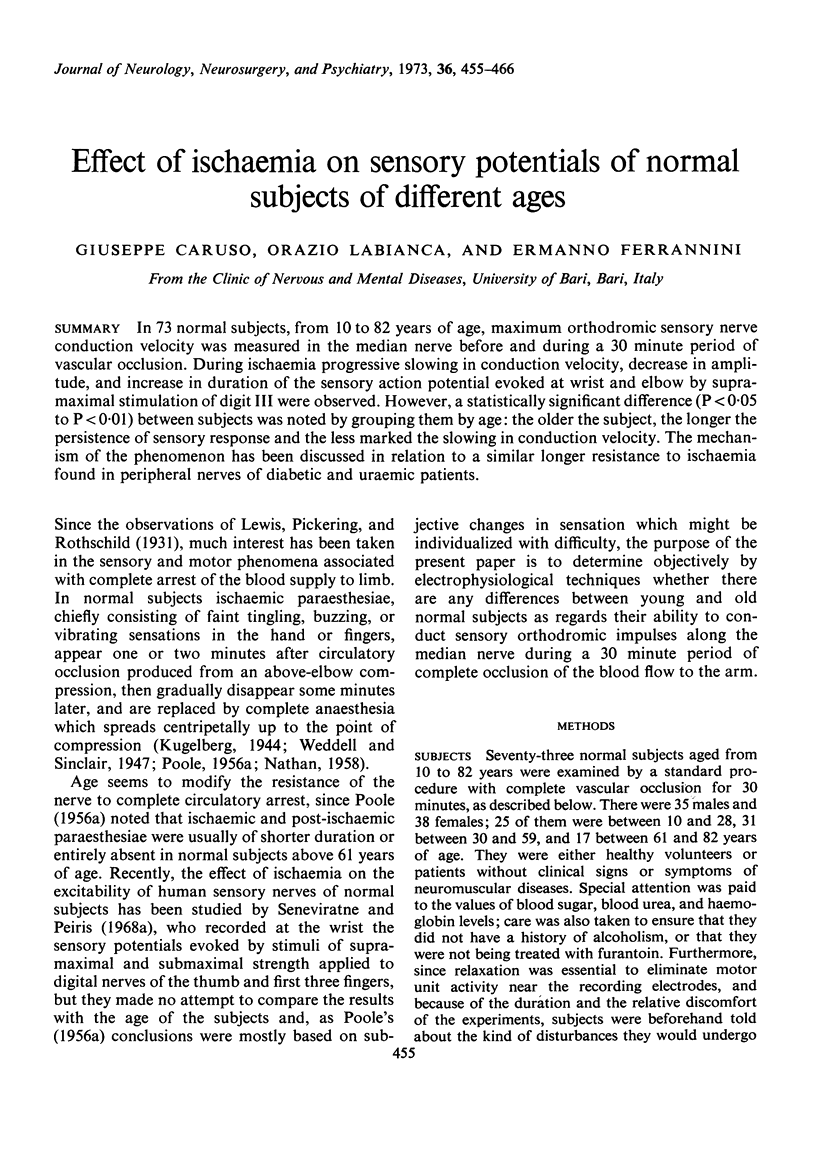
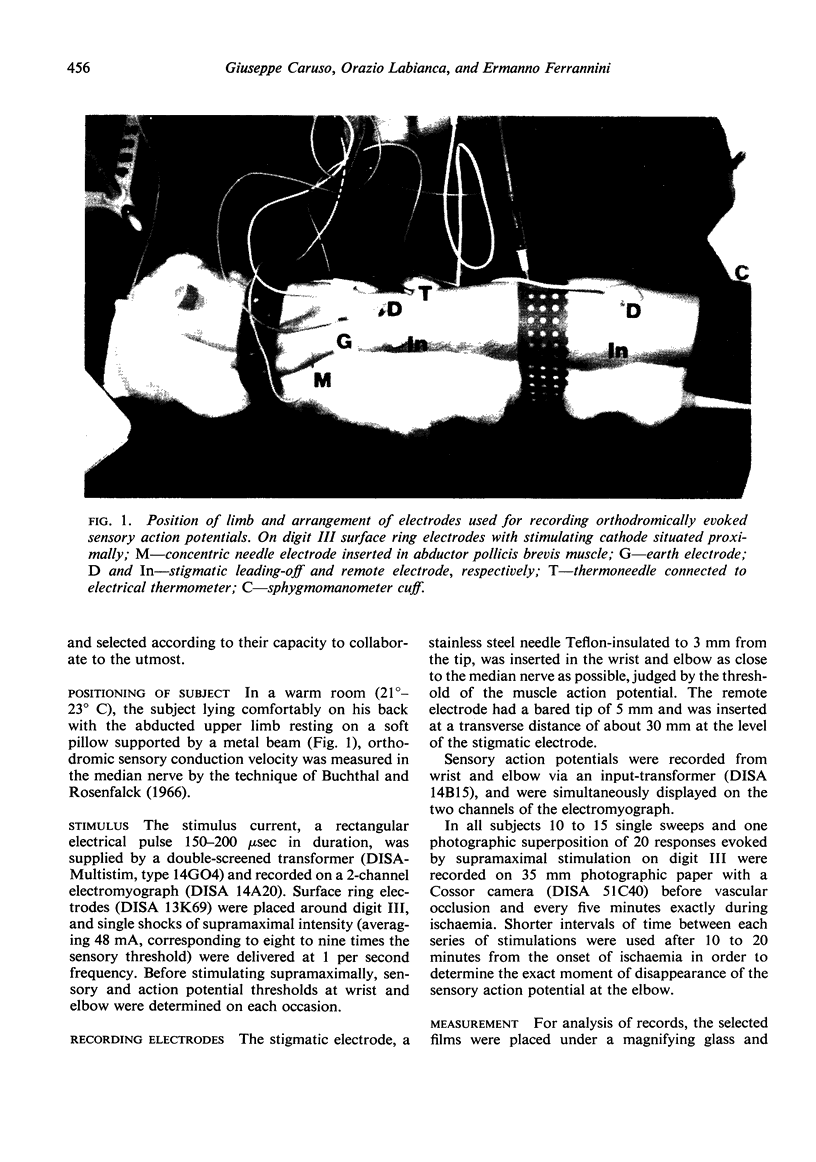
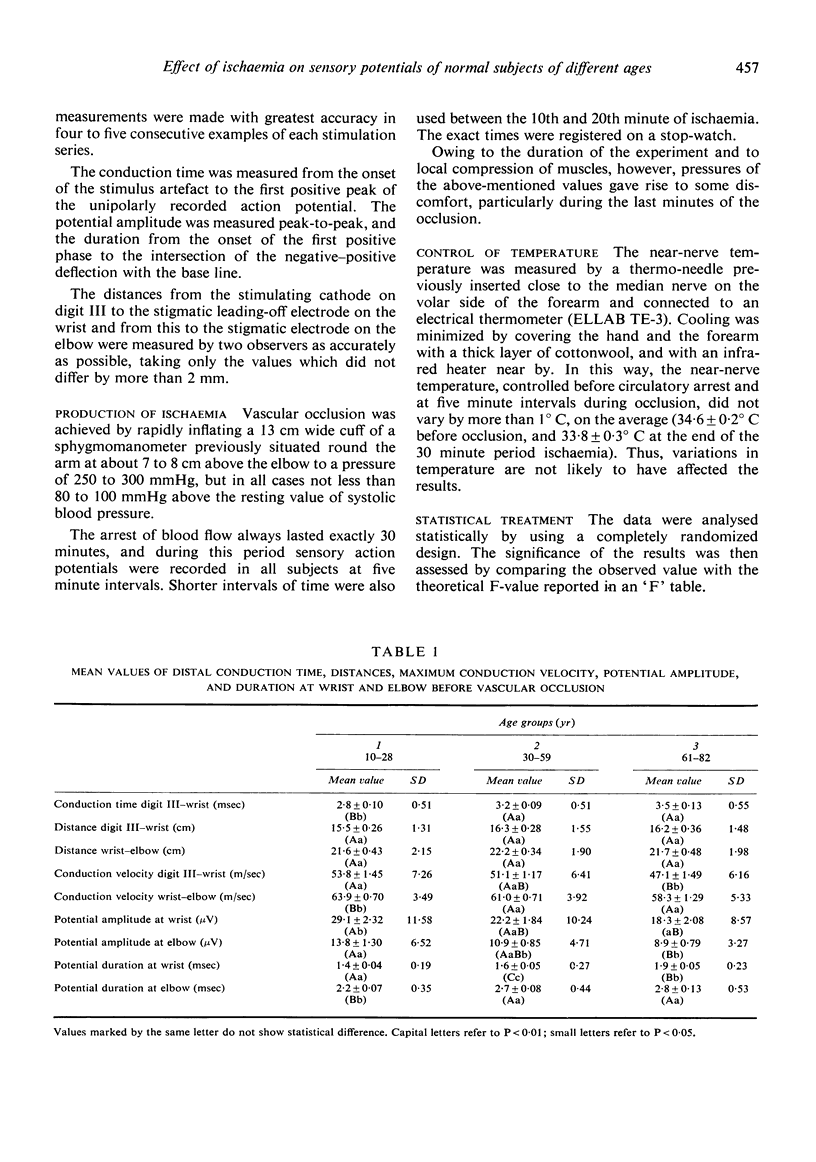


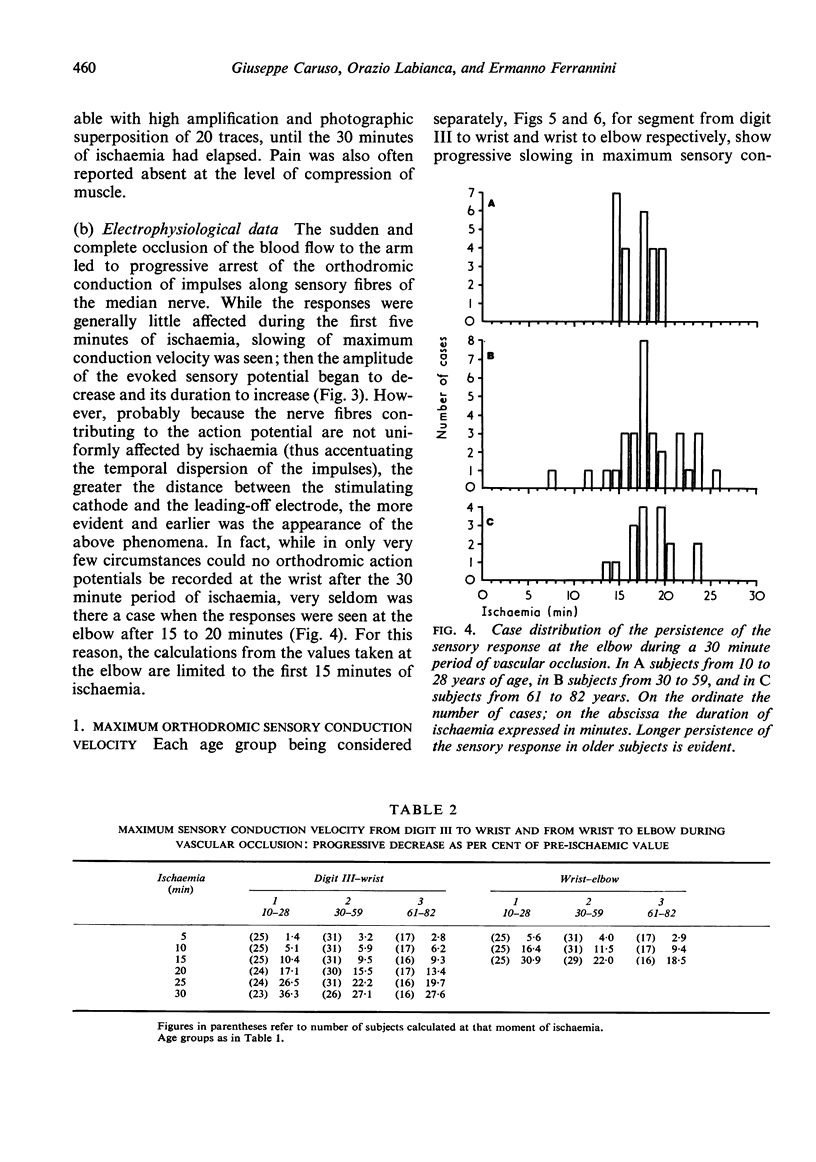
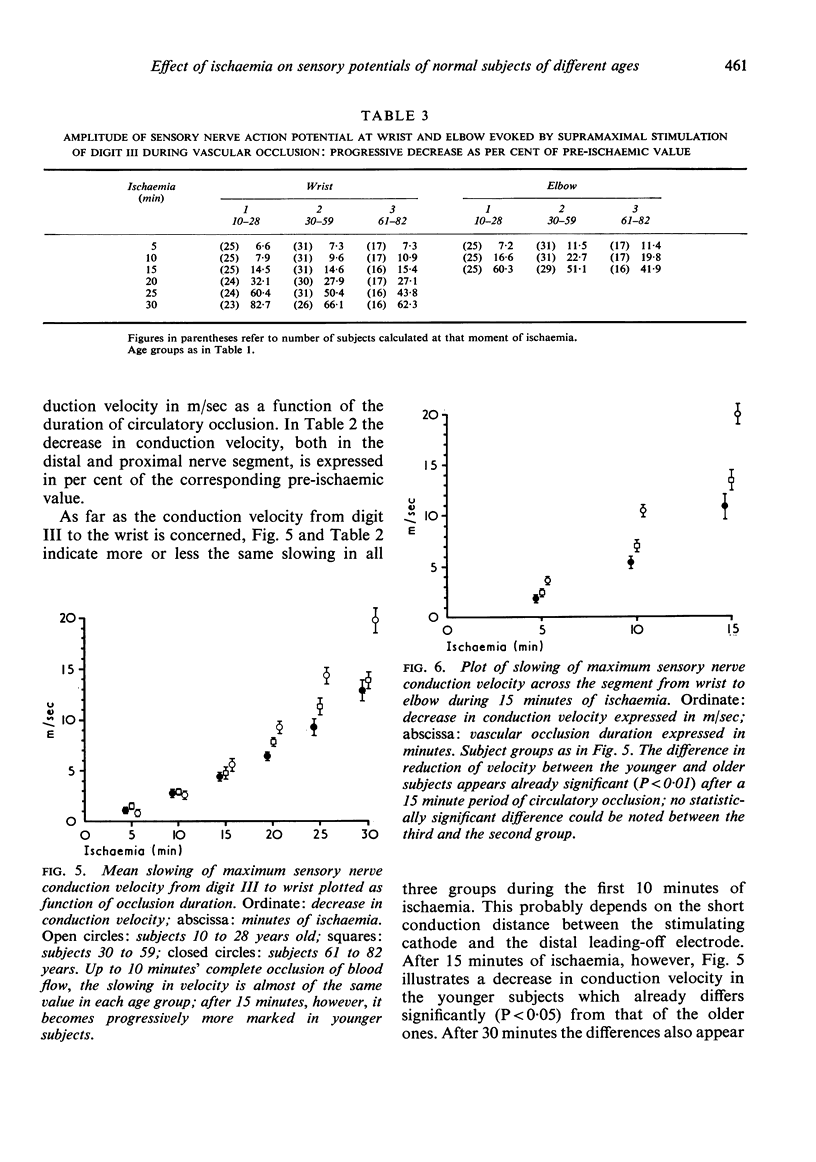

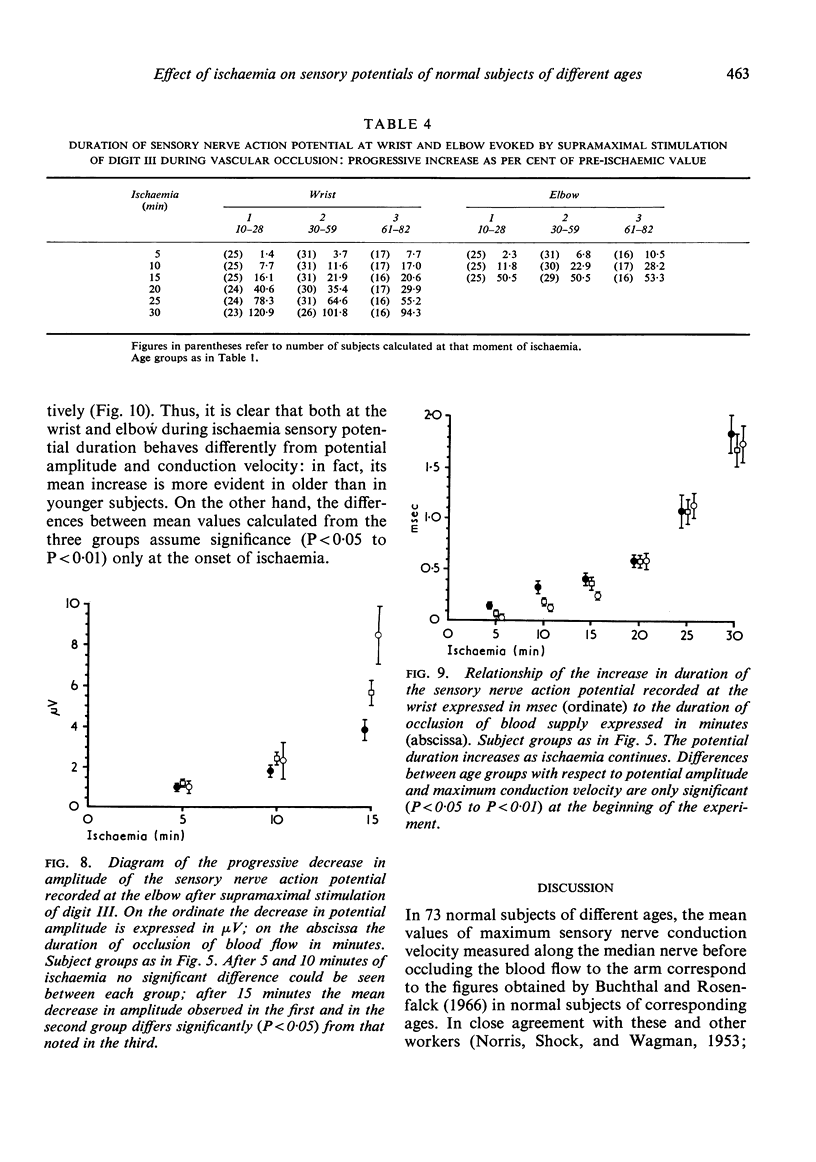

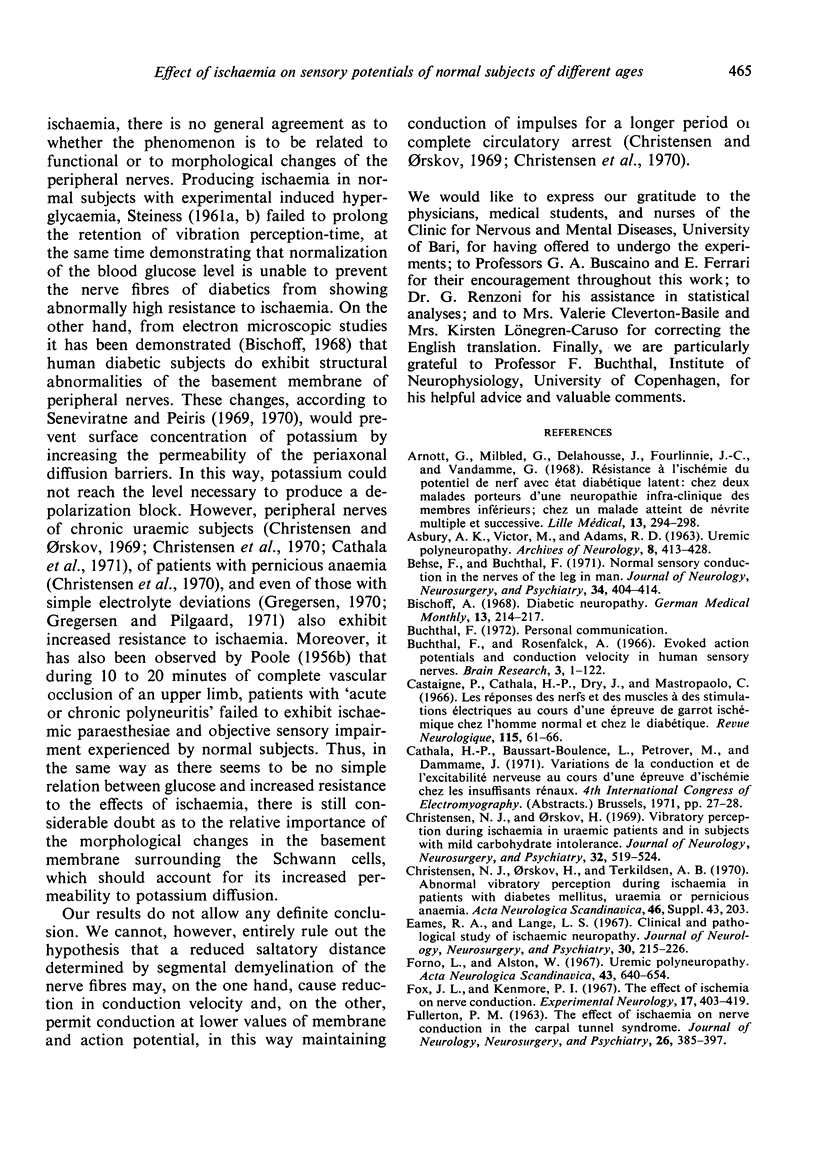
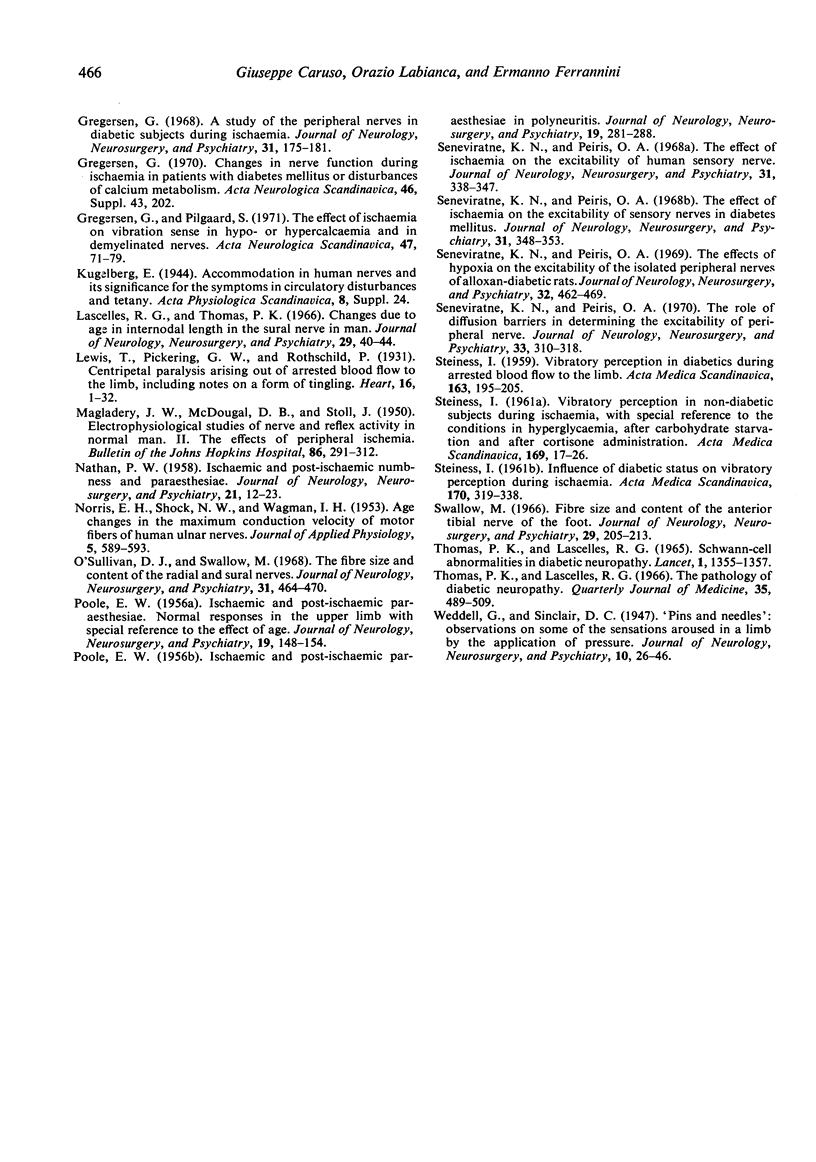
Images in this article
Selected References
These references are in PubMed. This may not be the complete list of references from this article.
- ASBURY A. K., VICTOR M., ADAMS R. D. Uremic polyneuropathy. Arch Neurol. 1963 Apr;8:413–428. doi: 10.1001/archneur.1963.00460040083008. [DOI] [PubMed] [Google Scholar]
- Arnott G., Milbled G., Delahousse J., Fourlinnie J. C., Vandamme G. Résistance à l'ischémie du potentiel de nerf avec état diabétique latent: chez deux malades porteurs d'une neuropathie infra-clinique des membres inférieurs; chez un malade atteint de névrite multiple et successive. Lille Med. 1968 Mar;13(3):294–298. [PubMed] [Google Scholar]
- Behse F., Buchthal F. Normal sensory conduction in the nerves of the leg in man. J Neurol Neurosurg Psychiatry. 1971 Aug;34(4):404–414. doi: 10.1136/jnnp.34.4.404. [DOI] [PMC free article] [PubMed] [Google Scholar]
- Bischoff A. Diabetic neuropathy. Morbid anatomy, patho-physiology and pathogenesis based on electron-microscopic findings. Ger Med Mon. 1968 May;13(5):214–passim. [PubMed] [Google Scholar]
- Castaigne P., Cathala H. P., Dry J., Mastropaolo C. Les réponses der nerfs et des muscles à des stimulations électriques AU COURS D'une epreuve de garrot ischémique chez l'homme normal et chez le diabétique. Rev Neurol (Paris) 1966 Jul;115(1):61–66. [PubMed] [Google Scholar]
- Christensen N. J., Orskov H., Terkildsen A. B. Abnormal vibratory perception during ischaemia in patients with diabetes mellitus, uraemia or pernicious anaemia. Acta Neurol Scand. 1970;46(Suppl):203–203. [PubMed] [Google Scholar]
- Christensen N. J., Orskov H. Vibratory perception during ischaemia in uraemic patients and in subjects with mild carbohydrate intolerance. J Neurol Neurosurg Psychiatry. 1969 Dec;32(6):519–524. doi: 10.1136/jnnp.32.6.519. [DOI] [PMC free article] [PubMed] [Google Scholar]
- Eames R. A., Lange L. S. Clinical and pathological study of ischaemic neuropathy. J Neurol Neurosurg Psychiatry. 1967 Jun;30(3):215–226. doi: 10.1136/jnnp.30.3.215. [DOI] [PMC free article] [PubMed] [Google Scholar]
- FULLERTON P. M. THE EFFECT OF ISCHAEMIA ON NERVE CONDUCTION IN THE CARPAL TUNNEL SYNDROME. J Neurol Neurosurg Psychiatry. 1963 Oct;26:385–397. doi: 10.1136/jnnp.26.5.385. [DOI] [PMC free article] [PubMed] [Google Scholar]
- Forno L., Alston W. Uremic polyneuropathy. Acta Neurol Scand. 1967;43(5):640–654. doi: 10.1111/j.1600-0404.1967.tb05559.x. [DOI] [PubMed] [Google Scholar]
- Fox J. L., Kenmore P. I. The effect of ischemia on nerve conduction. Exp Neurol. 1967 Apr;17(4):403–419. doi: 10.1016/0014-4886(67)90127-6. [DOI] [PubMed] [Google Scholar]
- Gregersen G. A study of the peripheral nerves in diabetic subjects during ischaemia. J Neurol Neurosurg Psychiatry. 1968 Apr;31(2):175–181. doi: 10.1136/jnnp.31.2.175. [DOI] [PMC free article] [PubMed] [Google Scholar]
- Gregersen G. Changes in nerve function during ischaemia in patients with diabetes mellitus or disturbances of calcium metabolism. Acta Neurol Scand. 1970;46(Suppl):202–202. doi: 10.1111/j.1600-0404.1970.tb02185.x. [DOI] [PubMed] [Google Scholar]
- Gregersen G., Pilgaard S. The effect of ischaemia on vibration sense in hypo- or hypercalcaemia and in demyelinated nerves. Acta Neurol Scand. 1971;47(1):71–79. doi: 10.1111/j.1600-0404.1971.tb07465.x. [DOI] [PubMed] [Google Scholar]
- Lascelles R. G., Thomas P. K. Changes due to age in internodal length in the sural nerve in man. J Neurol Neurosurg Psychiatry. 1966 Feb;29(1):40–44. doi: 10.1136/jnnp.29.1.40. [DOI] [PMC free article] [PubMed] [Google Scholar]
- MAGLADERY J. W., McDOUGAL D. B., Jr, STOLL J. Electrophysiological studies of nerve and reflex activity in normal man. II. The effects of peripheral ischemia. Bull Johns Hopkins Hosp. 1950 May;86(5):291–312. [PubMed] [Google Scholar]
- NORRIS A. H., SHOCK N. W., WAGMAN I. H. Age changes in the maximum conduction velocity of motor fibers of human ulnar nerves. J Appl Physiol. 1953 Apr;5(10):589–593. doi: 10.1152/jappl.1953.5.10.589. [DOI] [PubMed] [Google Scholar]
- O'Sullivan D. J., Swallow M. The fibre size and content of the radial and sural nerves. J Neurol Neurosurg Psychiatry. 1968 Oct;31(5):464–470. doi: 10.1136/jnnp.31.5.464. [DOI] [PMC free article] [PubMed] [Google Scholar]
- POOLE E. W. Ischaemic and post-ischaemic paraesthesiae; normal responses in the upper limb with special reference to the effect of age. J Neurol Neurosurg Psychiatry. 1956 May;19(2):148–154. doi: 10.1136/jnnp.19.2.148. [DOI] [PMC free article] [PubMed] [Google Scholar]
- STEINESS I. Influence of diabetic status on vibratory perception during ischaemia. Acta Med Scand. 1961 Sep;170:319–338. doi: 10.1111/j.0954-6820.1961.tb00245.x. [DOI] [PubMed] [Google Scholar]
- STEINESS I. Vibratory perception in diabetics during arrested blood flow to the limb. Acta Med Scand. 1959 Mar 4;163(3):195–205. doi: 10.1111/j.0954-6820.1959.tb10400.x. [DOI] [PubMed] [Google Scholar]
- Seneviratne K. N., Peiris O. A. The effect of ischaemia on the excitability of human sensory nerve. J Neurol Neurosurg Psychiatry. 1968 Aug;31(4):338–347. doi: 10.1136/jnnp.31.4.338. [DOI] [PMC free article] [PubMed] [Google Scholar]
- Seneviratne K. N., Peiris O. A. The effect of ischaemia on the excitability of sensory nerves in diabetes mellitus. J Neurol Neurosurg Psychiatry. 1968 Aug;31(4):348–353. doi: 10.1136/jnnp.31.4.348. [DOI] [PMC free article] [PubMed] [Google Scholar]
- Seneviratne K. N., Peiris O. A. The effects of hypoxia on the excitability of the isolated peripheral nerves of alloxan-diabetic rats. J Neurol Neurosurg Psychiatry. 1969 Oct;32(5):462–469. doi: 10.1136/jnnp.32.5.462. [DOI] [PMC free article] [PubMed] [Google Scholar]
- Seneviratne K. N., Peiris O. A. The role of diffusion barriers in determining the excitability of peripheral nerve. J Neurol Neurosurg Psychiatry. 1970 Jun;33(3):310–318. doi: 10.1136/jnnp.33.3.310. [DOI] [PMC free article] [PubMed] [Google Scholar]
- Swallow M. Fibre size and content of the anterior tibial nerve of the foot. J Neurol Neurosurg Psychiatry. 1966 Jun;29(3):205–213. doi: 10.1136/jnnp.29.3.205. [DOI] [PMC free article] [PubMed] [Google Scholar]
- THOMAS P. K., LASCELLES R. G. SCHWANN-CELL ABNORMALITIES IN DIABETIC NEUROPATHY. Lancet. 1965 Jun 26;1(7400):1355–1357. doi: 10.1016/s0140-6736(65)92154-9. [DOI] [PubMed] [Google Scholar]



